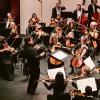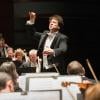
The California Symphony, noted for its unusual programming, tried something a little more unusual in its March 16 concert at the Lesher Center for the Arts in Walnut Creek. This was a program almost entirely for winds, brass, and percussion: no strings. Though the numbers onstage were small, Artistic and Music Director Donato Cabrera conducted the lot.
The only string player was the Symphony’s concertmaster, Jennifer Cho, who was the soloist in Lou Harrison’s Concerto for Violin With Five Percussionists. The percussionists — California Symphony member Allen Biggs, San Francisco Symphony player Raymond Froehlich, San Francisco Opera Orchestra player Patti Niemi, and freelancers Ben Paysen and Tim Dent — were the only orchestra.
The percussion battery was designed by the composer to imitate the style and sound of a Balinese gamelan with instruments and materials commonly found in America. It included the usual range of gongs, drums, bells, cymbals, shakers, and more, plus flowerpots, coffee cans, trash cans, and other oddities. The result was a great variety of sounds.

Harrison intended this work to maximize the contrast between percussion and violin. While the percussion mostly treaded softly in the background, occasionally erupting into forte passages, Cho’s part emerged in a wandering stream-of-consciousness manner. Most of the violin’s continuous not-quite-tonal music was high-pitched and without vibrato. It sounded thin and lonely, especially in unaccompanied passages. Other sections attempted interaction with the percussion, some of it abrupt and snappy.
The third and final movement was more rhythmic than the rest, adding a slight Middle Eastern flavor to the music. Cho then proved her own affinity for highly rhythmic music with her encore, the lively, slashing showpiece “Funk the String” by the virtuoso violinist Aleksey Igudesman. This piece has special meaning for Cho, as Igudesman dedicated it to his brother Leon, who is Cho’s friend and colleague in the SF Opera Orchestra.
The other pieces on the concert were each for 13 wind instruments. Richard Strauss’s Serenade in E-flat Major, Op. 7, is an even earlier work than its opus number might imply. He was about 17 when he wrote it. Scott Foglesong’s program note warned listeners not to expect anything like one of Strauss’s epic tone poems: “That Richard Strauss hadn’t been invented yet.”

Instead, it’s a charming piece in an already out-of-date early-19th-century style, with a gently wafting main theme, rather as if Carl Maria von Weber or Felix Mendelssohn had written it. (Another early Strauss work for the same forces, the Suite in B-flat Major, Op. 4, sounds more 18th century.) The Serenade’s rich mixed sonorities are impressive despite the composer’s youth and are the aspect most reminiscent of the Strauss that was invented later. They were vivid in this performance.
A slightly different complement of 13 wind instruments assembled to play Mozart’s expansive Serenade No. 10 in B-flat Major, K. 361, known as the “Gran Partita.” Instead of flutes, Mozart calls for two basset horns, larger cousins of the clarinet. The bass line of this piece is often played by a string bass, but Cabrera followed Strauss’s example for the Mozart as well. Both works were anchored by a contrabassoon, played by Shawn Jones, making for a purely wind sound throughout.
The “Gran Partita” is as unbroken an outpouring of pure Mozartian melody as anything the composer wrote. Cabrera took the work rather quickly, especially the third movement Adagio – the music that sends Antonio Salieri into jealous raptures in the movie Amadeus. Despite the speed, this was some three-quarters of an hour of blissful sound. With the winds in front, unmuffled by any strings, the volume was almost teeth-rattling in its intensity.
This was an excellent opportunity to hear music that’s rarely performed, too large for a chamber concert, too small for most conceptions of a symphony concert. Despite the fame of the “Gran Partita” in recordings, have you ever heard a performance live? Here was another imaginative California Symphony production masterminded by Cabrera.




